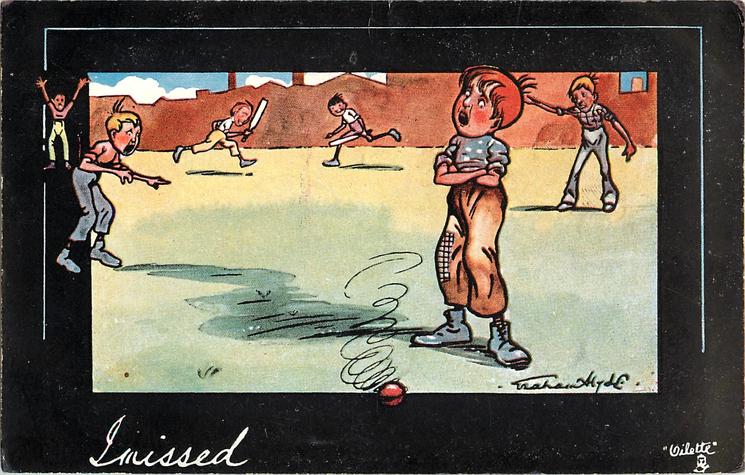Eleanor “Ellie” McCrackin
The Story of Graham Hyde
When the research for this Postcard History article began, one of the first bits discovered was the following: Graham Hyde was born in the northern industrial town of Sheffield, Yorkshire, sixth of ten children. The course of his life and the circumstances surrounding his education as an artist are still a mystery ….
Well, no longer!
***
Historians have suggested that people around the world who have influenced society in ways like being an artist, teacher, writer, or a public personality such as a politician never really die until the day on which his/her name is said for the last time.
This is an entertaining hypothesis to ponder, but the good, the bad, and the ugly have thousands of books written about them, therefore they may never die or be lost to society. But then there is an equal number of individuals whose lives were lived in ways – shall we say, “less conspicuous.” These are they who are reduced to a three-line obituary in a metropolitan newspaper.

London Daily Telegraph, March 20, 1951.
Graham Hyde died March 16, 1951 at High Green, Godalming.
It is with a measurable degree of disappointment that the search for information on the English artist and educator Graham Hyde was abandoned before his story was told. Over the years, it seems, those who sought out Mr. Hyde were satisfied with the knowledge that he was an artist who apparently worked for Raphael Tuck & Sons. There are a few insignificant canvases that can still be found in flea-market art galleries, but nothing more is known, in published art inventories or in museum holdings. The last-known canvas found was in a market stall in southern England. It was an oil on a scrap of canvas that was 5.5” by 7.5” – slightly larger than a postcard.
Until the research at Postcard History was undertaken, what was known about Hyde wouldn’t fill an index card. We knew he was born in Sheffield, England, in 1874. His father Thomas was the clerk of the Holy Order at Bierlow. His mother, Eliza married Thomas in 1854. When Graham was born he joined the family as the second son after his brother Thomas A. (later a teacher) and an elder sister Elizabeth (a second source states the eldest child was named Eleanor).
Graham first appeared in the national census of 1881. A decade later at age 17 he was listed as a son living with his parents and in 1901 is listed again as a boarder at the ecclesiastical parish house.
It is likely that in the decade that followed, Graham made some meaningful changes in his life. His first contributions to the Tuck catalog appeared in 1907, and by 1911 he had relocated to Kent to live with his brother – where on census day in 1911, he signed the census document for himself as a 37-year-old, single (unmarried) artist.
Parenthetically, Hyde’s signature on the census record is identical to his signed-artist signature.
What must have been a highlight in his life was his first foreign trip in January 1911 to Melbourne, Australia. Regrettably nothing noteworthy could be found about the time he spent there.
His second art adventure was on board the H.M.S. Lusitania bound for New York City in September 1913. By then he was a well-established artist working for Tuck. Could we assume that during his American adventure that he visited Tuck’s New York office?
From his time in New York until his death in 1951 in Surrey, England, little else was discovered but the three-line obituary which appeared in The (London) Daily Telegraph of March 20, 1951 declared that he was the Master at Aysgarth School, an independent day and boarding preparatory school near Newton-le-Willows, North Yorkshire. Also, evidence of an association as an art teacher at the Godalming School was a pleasant part of his life. At first the Godalming School, 31 miles south-west of London taught classes at the elementary level but became a sixth-form college (where the equivalent of grades 13 and 14 are completed).
At his death, Hyde’s estate amounted to £2,195 (Pounds Sterling). It was received in total by his spinster sister, Elizabeth.
Hyde’s contributions to Tuck’s catalog were several – it may have been his most dependable source of income. He completed at least twenty-five, six-cards sets and several individual cards, numbering more than 155 cards.
***
If you care to examine his work, the Tuck catalog is online at tuckdb.org. You may be surprised at some of his topics. They include many village scenes, the faces and antics of many men of Chinese extraction, and two sets of African children. He also did several “Write away” card sets.
***
Two favorites among Hyde collectors are the “Don’t Worry, Smile” set that feature men of advanced age, all with devilish smiles. Each depicts a classy fellow who may have simply heard an outlandish joke. This set was sold in the UK, Canada, South Africa, and the USA. The second group is one of Hyde’s very few sports themed sets. They show young boys playing on a cricket field and are cleverly captioned with the excuses that might have been part of their defense. The cricket cards were sold only in the UK.












Sometimes it seems the life of an artist is very sad and lonely. At least we have a little more information on him now. He seemed to stay under the radar, which is good, I guess.
Thank You
On the positive side, he doesn’t appear to have done anything scandalous and he wasn’t a passenger on R.M.S. Lusitania in 1915.
Although some of the cricket humor is lost on this “Yank”, the “We couldn’t help smiling” card has a slapstick appeal which is pretty much universal.
What fun images! I am glad you found some more information about his life.